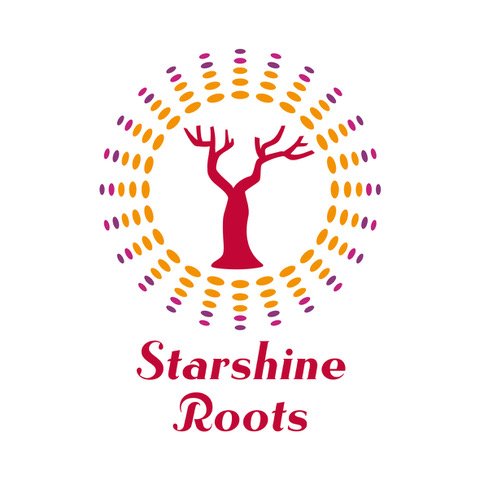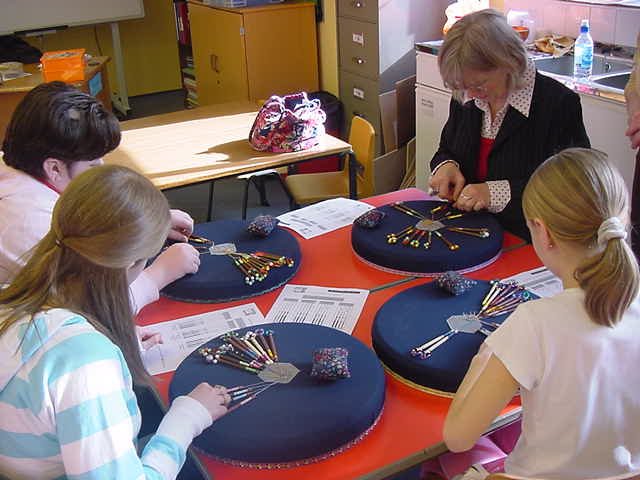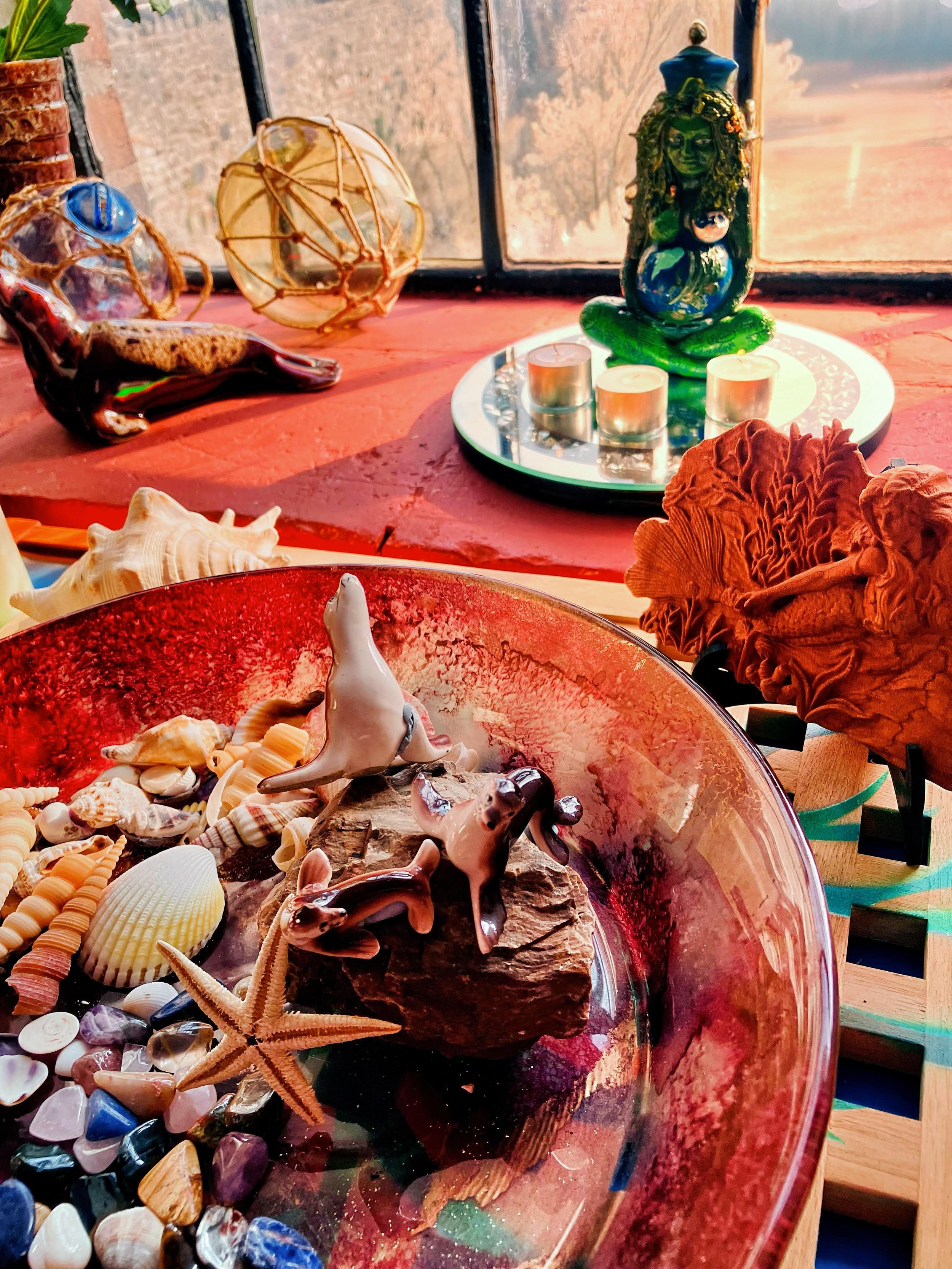The Art of holding Space
From lace bobbins to sound bowls; a journey of facilitating healing through deep listening
Finding connection in unexpected places
There I was, sitting on a Birmingham bus with a basket of lace bobbins on my lap, winding thread as the vehicle lurched through the Black Country. Fellow passengers stared or shifted seats, clearly wondering about the strange woman preparing crafting materials on public transport.
I smiled to myself. I'd achieved peak British eccentricity when a man would rather stand for eight stops than sit next to a woman wielding wooden bobbins. Their expressions which were part horror, part fascination suggested they feared I might suddenly entangle them all in an impromptu lace-making flash mob. What these bewildered commuters couldn't see was that these simple wooden tools would soon become gateways to healing.
The art of holding space is creating safe environments where people can explore, heal, and transform at their own pace. This has been the thread connecting my twenty-year journey across seemingly different fields. Whether using lace bobbins or sound bowls, I long ago discovered that true transformation emerges when we meet people exactly where they are.
As the Learning and Access Officer at the Lace Guild, I had developed a travelling exhibition to bring this traditional craft to "hard to reach" audiences.
Despite battling IBS (which I now understand was my body's way of processing unresolved trauma), I navigated the public transport system carrying these delicate materials to places to new audiences.
I'll never forget walking into that teenage pregnancy unit for the first time. Their skepticism felt like ice - eyes rolled, arms crossed, bodies turned away. My carefully planned workshop suddenly felt irrelevant. Instead of pushing forward with my agenda, I set the lace aside and simply began asking questions, listening to their stories, and meeting them where they were.
Gradually, the energy in the room shifted. One by one, they leaned in, picked up the bobbins, and began the rhythmic movements of basic lace-making. What happened next surprised everyone, especially the school's headmistress. The repetitive, focused activity created a meditative state that these young women rarely experienced. The room fell into a peaceful quiet, punctuated only by the gentle clicking of wood against wood.
The program was so successful that the headmistress invited me back long after the funding had ended.
What had begun as a craft workshop had transformed into something closer to meditation - a healing space where young women could escape the chaos of their circumstances and find moments of peace within.
“Twenty years later, I create similar spaces with sound bowls instead of lace bobbins. The tools have changed, but the essence remains the same: holding space for transformation by meeting people where they are and creating environments where healing can naturally emerge.”
Building flow and community: The space in-between
I root my space-holding practice in creating what psychologist Mihaly Csikszentmihalyi calls "flow" - those precious moments when people become so absorbed in an experience that time seems to stand still. I've witnessed this phenomenon across remarkably different settings.
At Thinktank Science Museum, I watched families making medieval remedies with pestle and mortars in a workshop I had developed on medieval medicine.
Parents and children leaned in together, crushing herbs and creating ointments just as people had done daily centuries before. The activity was so engrossing that our twenty-minute workshop stretched to forty, with no one noticing the time passing. One grandmother, so immersed in the experience, began tasting the herbs without prompting, her curiosity completely natural and uninhibited.
These museum experiences taught me that profound learning emerges through relationship, not isolation. Vygotsky's concept of "scaffolding" played out before my eyes as parents provided gentle guidance without taking over.
In educational theory, scaffolding refers to the temporary support provided by a more knowledgeable person that helps a learner bridge the gap between what they can do independently and what they can achieve with assistance. Like physical scaffolding used in construction, these supports are gradually removed as the learner becomes more capable.
At the workshop, I observed parents intuitively offering just enough guidance, demonstrating techniques, asking questions, or suggesting approaches while allowing their children to explore and discover on their own terms. This delicate balance creates an optimal zone for learning where children feel both supported and autonomous. Children who typically disengaged in traditional classrooms thrived in these social, experiential environments.
“In my women’s drum circles today, I create similar conditions for flow and community learning.
The rhythmic, repetitive nature of drumming naturally induces a meditative state, just as the lace-making did for those young women years ago.
The learning happens collectively as women respond to and build upon each other’s rhythms, creating something together that transcends what any one person could create alone.”
The true power lies in the sacred container of community and that resonance that amplifies individual experience into collective wisdom.
In my drum circles, women discover not only their own embodied wisdom but a network of support that holds and reflects that wisdom back to them.
The power of direct experience: Beyond academic knowing
At the Hunterian Museum at the Royal College of Surgeons, surrounded by glass cases of medical specimens, I facilitated transformations that academic approaches could have never achieved. One day, a group of students arrived for a workshop on medical history - many of them labeled as "disengaged" or "underachieving" by their teachers who hovered nervously at the back of the room.
Instead of beginning with dates, facts, and historical context, I invited them to simply stand before the specimens - preserved hearts, lungs affected by industrial pollution, skeletal remains showing the physical toll of different professions. I asked them what they noticed, what they felt, what questions arose naturally.
The shift was remarkable. A young man who I later learnt hadn't spoken in class for weeks approached a specimen showing lung damage from coal mining. "My granddad worked in the mines," he said quietly. "His lungs probably looked just like this before he died." Suddenly, history wasn't an abstract timeline but a living connection to his own family story.
Another student, often dismissed as "difficult," spent several minutes with a specimen showing historical forceps used in childbirth. She began asking sophisticated questions about pain management and patient consent that even surprised her teachers. The object had created a doorway into ethics, empathy, and critical thinking that traditional school lessons had failed to open.
By the end of the session, previously silent students were leading discussions, forming connections, and engaging with complex topics on their own terms.
Their teachers watched in amazement as knowledge was discovered rather than delivered.
This experience fundamentally shaped how I hold space today.
“I am grateful to have learned early on that transformation happens when we trust people’s natural curiosity and embodied wisdom rather than positioning ourselves as the keepers of knowledge. ”
In my circles, I draw inspiration from seasonal folklore. But rather than lecturing about these traditions, I weave their essence into immersive experiences that women can feel and embody directly.
Guided meditations open doorways to personal connection. Embodied listening practices help women discover wisdom through their senses.
This immersive approach transforms how women relate to wisdom traditions.
Instead of learning about something, they experience it firsthand.
Seasonal energies, folklore, and sacred practices become alive and personally meaningful, integrated through physical sensation and emotional resonance rather than merely understood intellectually.
From crisis to community: Restoring pathologists' voices
At the Royal College of Pathologists, I encountered a profession in crisis. The Alder Hey and Bristol scandals around tissue collection without consent had left pathologists feeling scapegoated, misunderstood, and abandoned.
As Public Engagement Manager, I designed a discussion resource for A-level students about these ethical issues, which accomplished something unexpected: it not only educated students but helped pathologists reclaim their voice. By framing these complex ethical discussions in ways that invited genuine exploration rather than judgment, pathologists began to see how they could engage with these difficult topics rather than hide from them.
What started as a teaching resource became a healing tool for an entire profession. Pathologists who had felt silenced found ways to speak about their work with pride again. The membership that had been disengaged rekindled their relationship with the College. Within three years, our network of actively engaged pathologist volunteers grew from a handful to nearly 1500 strong.
This experience taught me the power of creating spaces where difficult emotions such as shame, fear, and uncertainty could be acknowledged and transformed. I now bring this understanding to my practice with clients who have experienced trauma.
Leadership as deep listening
My decade as a senior leader at organisations like the Vegan Society and Soil Association taught me that true space-holding goes far beyond traditional management. Leading diverse teams across different departments revealed that the most powerful change happens when people discover their own solutions.
When establishing the new Communications department at the Vegan Society, I brought together several new team members with varied backgrounds and working styles. Rather than imposing my approach, I created regular containers where they could share challenges without judgement. The most profound lesson I learned was to resist providing immediate solutions and instead ask powerful questions that helped team members uncover their own wisdom.
One memorable moment came during a tense rebrand negotiation at the Soil Association. Instead of advocating for my perspective, I facilitated a workshop where stakeholders with opposing viewpoints could truly hear each other.
By holding space for all voices - from board members concerned about heritage to younger staff focused on future growth - we found creative solutions that honoured both.
“This experience honed my ability to maintain presence amid competing needs and perspectives. The skills developed - deep listening, holding multiple truths simultaneously, creating spaces where people feel safe to explore - now form the foundation of my sound healing practice.”
The researcher's stance: presence without interference
Perhaps the greatest test of my space-holding abilities as a young woman came during my time as a qualitative researcher for an exhibition about chronic pain at the Science Museum London. My role was to support the facilitation of focus groups with chronic pain sufferers, drawing out their lived experiences to inform the exhibition content.
What made this particularly challenging was that I myself had been experiencing chronic pain for nearly two years. Each session became an exercise in presence and restraint; creating a space where participants felt safe to share their truths while carefully stepping back from inserting my own experience.
When one participant described feeling dismissed by medical professionals, my own memories of similar encounters surfaced strongly.
Rather than jumping in with "me too," I held that resonance silently while creating space for others to build on her experience. This delicate balance of being fully present with others' pain while containing my own, stretched my capacity for neutral witnessing beyond anything I'd experienced before.
The group dynamics required nuanced facilitation. Some participants were angry, others resigned. Some needed to be heard, while others needed to know they weren't alone. Creating a group that could hold all these needs simultaneously required deep attunement.
What emerged were remarkably rich insights that challenged conventional medical narratives and brought lived experience to the forefront. The exhibition ultimately reflected not just facts about pain but the human journey of living with it.
“This researcher’s stance now informs every healing session I facilitate. Whether in women’s circles or one-on-one sessions, I create each voice and is honoured without imposing my interpretations. This ability to maintain deep presence while suspending judgment allows women to reconnect with their own wisdom.”
The space between who you've been and who you're becoming
Twenty years of creating experiential spaces - from museum galleries to corporate boardrooms to women's circles - has revealed a profound truth:
People don't need more information. They need supportive environments where innate wisdom can resurface.
I've designed settings where questions spark discovery more powerfully than answers ever could. Where being truly witnessed cultivates deeper insights than any teachings.
My path from museum education officer to sound healer reflects my evolving understanding of presence.
I've watched pregnant teenagers find serenity through lace-making, pathologists reclaim their voices after serious professional challenges, and women rediscover their true nature through somatic activities.
Through these diverse experiences, I've refined a singular approach: creating spaces where natural unfolding happens with authenticity and depth.
Today, I offer 1-1 healing sessions where I support you to discover your own wisdom in a space where you're truly heard. If you’d like to find out more about how we can work together, I am offering 20 minute discovery calls.















